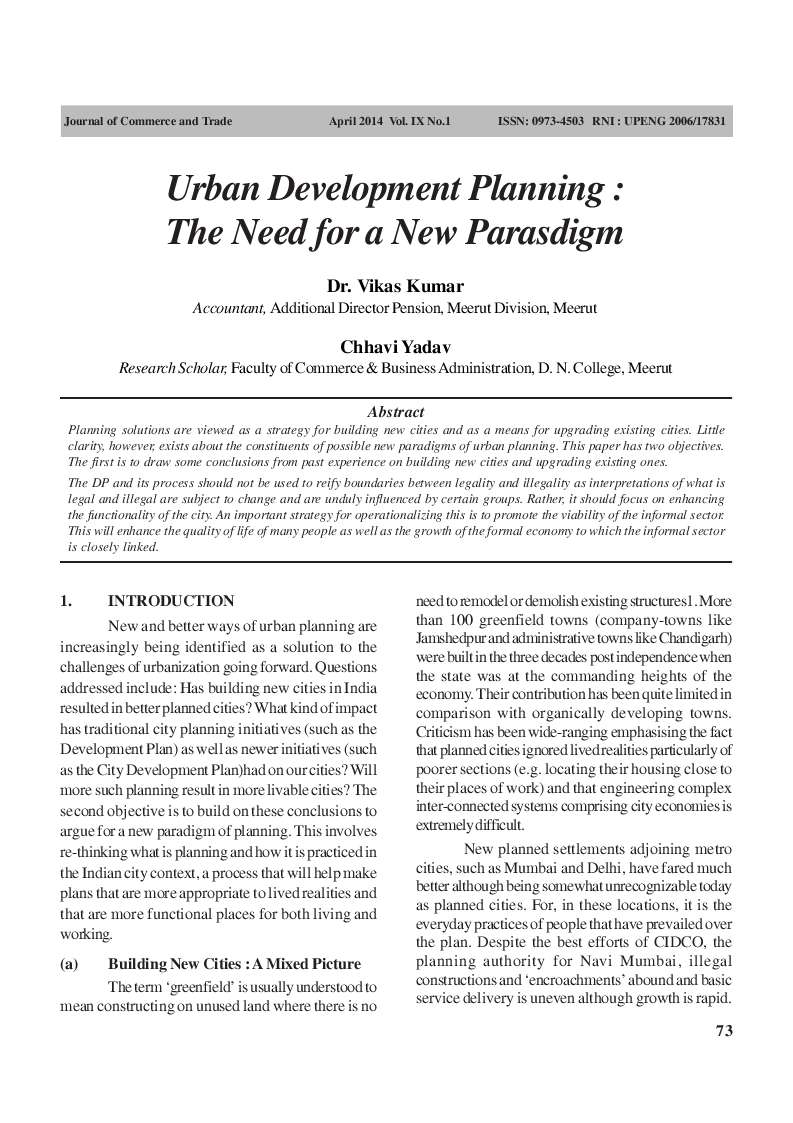Urban Development Planning: The Need for a New Paradigm
DOI:
https://doi.org/10.26703/jct.v9i1.153Keywords:
Urban Development PlanningAbstract
Planning solutions are viewed as a strategy for building new cities and as a means for upgrading existing cities. Little clarity, however, exists about the constituents of possible new paradigms of urban planning. This paper has two objectives. The first is to draw some conclusions from past experience on building new cities and upgrading existing ones. The DP and its process should not be used to reify boundaries between legality and illegality as interpretations of what is legal and illegal are subject to change and are unduly influenced by certain groups. Rather, it should focus on enhancing the functionality of the city. An important strategy for operationalizing this is to promote the viability of the informal sector. This will enhance the quality of life of many people as well as the growth of the formal economy to which the informal sector is closely linked.
Downloads
Metrics
References
Benjamin, S. (2010). “The aesthetics of the ‘ground-up’ city,” in Seminar <http://www.india-seminar. com/2010/612/612 solomon_benjamin.htm> Accessed July 5, 2014.
Citizens Groups. (2009). “Half Time or Time Out: Citizen’s Review- Jawaharlal Nehru National Urban Renewal Mission-A Collective View from Below”, Hazards Centre, New Delhi.
Eger, J. (2003). “Smart communities: becoming smart is not so much about developing technology as about engaging the body politic to reinvent governance in the digital age,” in Urban Land 60:1, pg. 50-55.
Graham, S. and Marvin, S. (2001). Splintering Urbanism: Networked Infrastructures, Technological Mobilities and the Urban condition. London: Rouledge.
Graham, S. (2002). “Bridging urban digital divides: urban polarization and information and communication technologies,” in Urban Studies 39:1, pg. 33-56.
Greenfield,A. Oct23 (2013). “Against the Smart city” Accessed Jun 25, 2014.
Hazards Centre. (2008). “Challenge to Mission” Report of National Seminar on JNNURM, 21-22 Jun, Delhi.
Holland, Robert G. (2008). “Will the real smart city please stand up?” in City: analysis of urban trends, culture, theory, policy, action 12:3, pg 303-320.
Kamath, L. and P. Deekshit. May 31 (2014). “Planning as Practice? Governing Conjunctures and Informal Urbanisation in Solapur Town,” in Economic and
Political Weekly Review of Urban Affairs, XLIX:22,pg. 72-81.
Kamath, L. and Y. Zachariah. (2013). “How have the JNNURM and UIDSSMT programmes affected infrastructure and governancne outcomes in cities and towns in India? Reviewing the state of knowledge,” Working Paper, Tata Institute of Social Sciences, Mumbai.
Mahadevia, Darshini. (2011). “Branded and Renewed? Policies, Politics and Processes of Urban Development in the Reform Era”, Economic and Political Weekly, Vol XLVI: 31, pg. 56-64.
Mohan, A. and C. Rajagopal. (2010). “Outsourcing Governance? Revising the
Master Plan of Bangalore” Paper presented at the 46th ISOCARP Congress, 19-23 Sept, Nairobi.
Mukhopadhyay, P. (2011). “Formality and Functionality in Indian Cities,” in Seminar <http://www.india-seminar.com/2011/617/617_partha mukhopadhyay.htm > Accessed July 3, 2014.
National Commission for Enterprises in the Unorganized Sector
Roy, A. (2009). “Why India Cannot Plan Its Cities: Informality, insurgency, and the Idiom of Urbanisation,” in Planning Theory, 8:1, pg. 76-87.
Shetty, P., Rupali Gupte and P. Khanolkar. Oct 28, (2012). “Gurgaon Glossaries” Accessed July 1, 2014.
Siemens Corporation. “Sustainable Buildings — Networked Technologies: Smart Homes and Cities,” Pictures of the Future, Fall (2008). foryoutou.se/ siemenstotal.

Additional Files
Published
How to Cite
Issue
Section
License
Copyright (c) 2014 Journal of Commerce and Trade

This work is licensed under a Creative Commons Attribution 4.0 International License.







